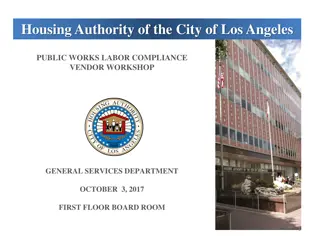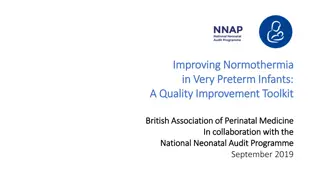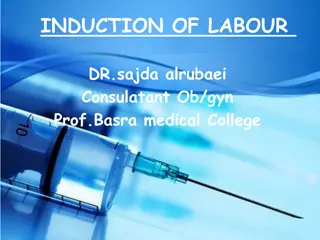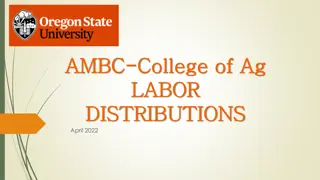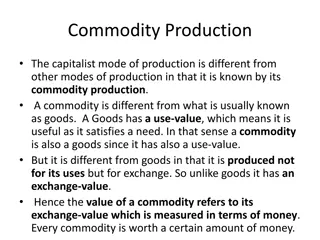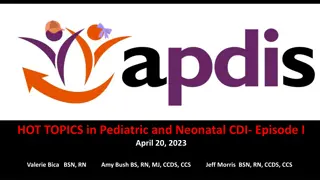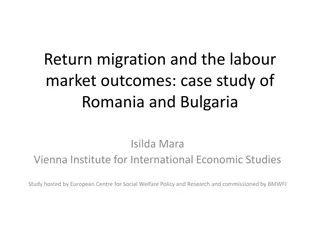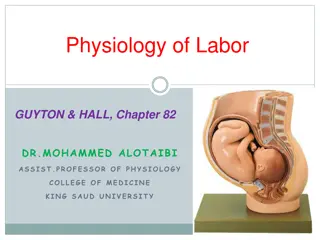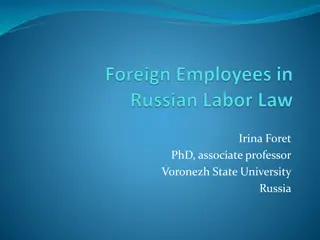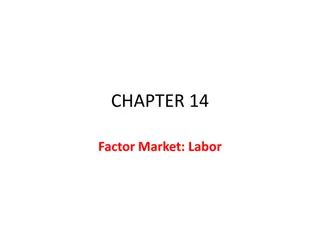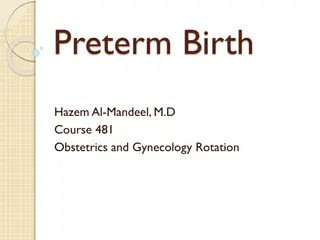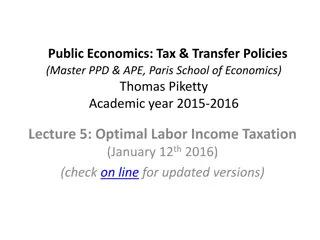Debates on the Mode of Production in Indian Agriculture
Dr. S. Mehdi Abbas Zaidi and Ms. Bushra Fatima discuss the elements of production in Indian agriculture, including the objects of labor, instruments of labor, and the role of labor itself. They explain how these components interact to form the productive power of labor and shape the relations of pro
1 views • 19 slides
Guidelines for Induction of Labor in Family Medicine Forum 2023
The new SOGC Induction of Labor Guidelines 2023 were introduced at the Family Medicine Forum by Dr. Hannah Shenker and Dr. Helen Mavromichalis from McGill University. The presentation discussed various scenarios for inducing labor and highlighted key recommendations, including the importance of shar
0 views • 41 slides
Employment and Labor Law in Russia: Overview and Legal Rights for Foreigners
Irina Foret, PhD, an associate professor at Voronezh State University, provides valuable insights into the general issues surrounding employment and labor law in Russia, with a focus on the legal status of foreigners, work permits, and protection of labor rights. The Russian Federation extends right
2 views • 27 slides
Alabama Child Labor Law Guidelines
Alabama's Child Labor Law establishes regulations concerning the minimum age to work, exemptions for certain types of work like lemonade stands and agriculture, requirements for Child Labor Certificates, eligibility criteria for minors aged 14 and 15, the necessity of displaying labor law posters, r
1 views • 28 slides
Public Works Labor Compliance Vendor Workshop by Housing Authority of the City of Los Angeles
The Housing Authority of the City of Los Angeles conducted a workshop to assist contractors in understanding their Public Works labor compliance responsibilities. The workshop covered topics such as contractor responsibilities, registration with the state under SB854, federal and state labor laws, a
1 views • 26 slides
Quality Improvement Toolkit for Improving Normothermia in Very Preterm Infants
This resource provides a comprehensive toolkit developed by the British Association of Perinatal Medicine in collaboration with the National Neonatal Audit Programme to assist clinicians in neonatal units in delivering normothermia to very preterm infants. It includes evidence-based interventions, d
1 views • 17 slides
Understanding Preterm Labor and Its Impact on Infant Health
Preterm labor, defined as the delivery of an infant before 37 weeks of gestation, presents risks such as incomplete organ system development and increased infant mortality rates. Unnecessary obstetrical interventions before 38-39 weeks should be avoided. The trends in preterm birth rates reveal disp
0 views • 68 slides
Improving Buccal Colostrum Provision for Preterm Babies in NICU
Early administration of buccal colostrum to preterm babies in the NICU has shown positive outcomes such as improved gut development, reduced infection rates, and enhanced breastfeeding rates. A Quality Improvement program at Our Lady of Lourdes Hospital aimed to provide buccal colostrum within 6 hou
1 views • 5 slides
Overview of Labor Law and Union Formation Process
Labor law governs the structure and operations of private labor relations in the United States. The National Labor Relations Act (NLRA) establishes the National Labor Relations Board (NLRB) to handle unfair labor practices in the private sector. The process of forming a union involves reaching out t
0 views • 11 slides
Economics of Labor Markets: Factors of Production and Labor Demand
The Economics of Labor Markets explores the markets for factors of production such as labor, land, and capital. Demand for these factors is derived from firms' decisions to produce goods. The labor market, governed by supply and demand forces, exhibits diminishing marginal product of labor due to fi
0 views • 41 slides
Tackling Child Labor in Uganda's Coffee Sector: A Project Approach
The "Child Education Project Uganda" led by Rashida Nakabuga aims to address the root causes of child labor in Uganda, particularly in the coffee sector. With a focus on poverty, gender inequality, and inadequate education, the project adopts a risk-based due diligence approach at the farm level to
0 views • 17 slides
Detection of Low-Grade Hemorrhages in Preterm Infants: Ultrasounds vs. MRIs
This study compares the effectiveness of head ultrasounds and brain MRIs in detecting low-grade hemorrhages in preterm infants. It discusses the incidence of intraventricular hemorrhage (IVH) in very low birth weight infants, classification of IVH, risk factors for IVH, outcomes related to IVH grade
9 views • 33 slides
Clinical Diagnosis and Assessment of Pre-Labour Rupture of the Membranes
Pre-Labour Rupture of the Membranes (RROM) is characterized by the leakage of amniotic fluid before the onset of labor, particularly when the gestational age is less than 37 weeks. Clinical diagnosis involves a thorough history evaluation and examination, including sterile speculum examination to co
0 views • 18 slides
Understanding Preterm Delivery: Causes, Complications, and Evaluation
Preterm delivery, defined as labor prior to 37 weeks of gestation, affects approximately 12% of pregnancies worldwide, with almost 30% of these deliveries occurring before 34 weeks. The etiology of preterm birth can vary from maternal factors such as PROM to fetal anomalies and multiple gestations.
0 views • 25 slides
Understanding Cesarean Section and Preterm Labor Risks
Cesarean section (C/S) is a delivery method for various fetal and maternal indications, while preterm labor poses risks like twin pregnancy, uterine abnormalities, and infections. Complications of C-sections and signs of preterm labor are discussed, highlighting the importance of early recognition a
0 views • 9 slides
Understanding Unfair Labor Practices vs. Grievances at FLRA, NLRB, and DC PERB
Unfair labor practices (ULPs) are violations of federal labor laws, while grievances involve disputes between labor organizations and agencies. Different reviewing authorities handle these matters: FLRA for federal, NLRB for private sector, and DC PERB for DC government agencies. Each organization h
0 views • 47 slides
Overview of Induction of Labour for Obstetric Practice
Induction of labor is the artificial initiation of the labor process before it begins naturally. This procedure is performed in cases such as premature rupture of membranes, prolonged pregnancy, preterm premature rupture of membranes, pre-eclampsia, and maternal medical conditions like diabetes or c
1 views • 30 slides
Labor Clauses with Institutionalized Cooperation Measures in FTAs: A Win-Win Outcome in North-South Relations
Labor provisions in Free Trade Agreements (FTAs) have been a subject of debate, with key discussions focusing on whether they benefit workers, prevent protectionism, and promote economic development. Research suggests that including labor clauses with institutionalized cooperation measures can have
0 views • 25 slides
Labor-Management Forum Reporting Tool Analysis
The Problem Resolution Subcommittee's presentation to the National Council on Federal Labor-Management Relations on January 15, 2014, highlighted the development and outcomes of the Labor-Management Forum (LMF) Reporting Tool. The tool aimed to address specific problems, identify barriers, and showc
0 views • 20 slides
Costing and Variance Analysis in Manufacturing Processes
The content discusses various scenarios related to costing and variance analysis in manufacturing processes. It addresses topics such as direct materials usage variance, direct labor mix and yield variances, total direct labor efficiency variance, and standard costing system variances. The examples
0 views • 8 slides
Labor Distribution Form and Process Overview
Understanding the labor distribution form process is crucial for managing changes in job duties and effort allocation. The OSRAA form is utilized for all labor distributions, ensuring accountability and clarity in budget allocations. Proper documentation and justification are key in facilitating smo
0 views • 48 slides
Understanding Commodity Production and Labor in Capitalist Mode
The capitalist mode of production is characterized by commodity production, where goods are produced not for their use but for exchange. The value of a commodity is determined by its exchange value, measured in money, which is influenced by the quantity of labor involved in its production. Labor, be
0 views • 8 slides
The Pullman Strike of 1894: Eugene Debs and Labor Unrest
The Pullman Strike of 1894 was a pivotal event in American labor history, led by Eugene Debs and the American Railway Union against the Pullman Company's unfair labor practices. Workers protested wage cuts and living conditions, sparking a nationwide strike that disrupted rail traffic. Despite facin
0 views • 18 slides
Understanding the Coding Guidelines for Preterm Newborns with Small for Gestational Age (SGA)
Explore the guidelines for coding preterm newborns who are small for gestational age, including birth weight considerations and criteria for assigning appropriate ICD-10 codes. Gain insights into differentiating SGA from low birth weight and effectively documenting neonatal cases.
0 views • 17 slides
Study on Return Migration and Labor Market Outcomes in Romania and Bulgaria
This study examines the impact of return migration on the labor market outcomes of Bulgarian and Romanian migrants, exploring factors influencing their decisions to return, such as labor market structure, monetary incentives, and family motives. The literature review indicates varying skill distribu
0 views • 15 slides
Understanding the Physiology of Labor in Pregnancy
Labor, also known as parturition, is the process of uterine contractions leading to the expulsion of the fetus. Various hormonal changes, including increased estrogen levels, play a crucial role in triggering and regulating labor. The progression from a quiescent uterus to active contractions involv
0 views • 29 slides
Comprehensive Guide to the Management of Normal Labor by Professor Muhsin-AL-Sabbak
Understanding the management of normal labor is crucial for healthcare professionals. This comprehensive guide covers the definition of normal vaginal delivery, diagnosis of labor, stages of labor, phases of labor, and the use of tools like partogram and cardiotocography to monitor progress. Profess
0 views • 9 slides
Physiology of Labor: Onset and Key Hormonal Changes
Labor, or parturition, involves uterine contractions leading to the fetus's expulsion. Factors triggering labor include hormonal changes like increased estrogen and decreased progesterone, which stimulate uterine muscle activity. Telocytes play a role in spontaneous uterine activity, while oxytocin
0 views • 36 slides
Compliance with Labor Standards in Federal Contracts
Learn about key regulations and statutes such as the Copeland Act, Contract Work Hours and Safety Act, and Davis-Bacon Act that govern labor standards for federal projects. Understand the steps to comply with Davis-Bacon labor standards, including wage decisions, requesting wage determinations, and
0 views • 27 slides
Migration Policies and Labor Laws in Russia: A Comprehensive Overview
Irina Foret, PhD, an associate professor at Voronezh State University, delves into the legal status of foreigners in Russia, including work visas, labor rights violations, and legal remedies. Key aspects such as Article 62 of the Constitution and Article 11 of the Labor Code are discussed, highlight
0 views • 30 slides
Impacts of Labor Productivity by Age and Changes in Age Structure on Labor Productivity in Vietnam
This research focuses on quantifying the impact of labor productivity by age on the overall economy's labor productivity in Vietnam. Utilizing analytical methods like the Cobb-Douglas production function and Shift-Share Analysis, the study aims to understand how changes in age structure and labor sh
0 views • 26 slides
Induction of Labor: Methods and Considerations
Induction of labor is done to achieve vaginal delivery before spontaneous onset, usually at 39 weeks or when medically necessary. Risks include failed induction, cesarean section, uterine rupture, prolonged labor, and infections. Cervical ripening methods help prepare the cervix for labor. The Bisho
0 views • 18 slides
Understanding Competitive Factor Market in Labor Economics
A competitive factor market involves a large number of sellers and buyers of a factor of production, like labor. With no single entity influencing prices, each acts as a price taker. The demand for factors depends on firms' output levels and input costs, leading to derived demands. Profitability of
0 views • 43 slides
Understanding Labor Productivity Growth in Europe: Insights from Productivity Project Conference
Divergent experiences in labor productivity growth between the US and Europe have sparked interest in analyzing factors affecting productivity. The Productivity Project Conference in January 2015 delved into macro and micro-level determinants of labor productivity, focusing on Total Factor Productiv
1 views • 27 slides
Department of Employment and Labour: Vision, Mandate, and Objectives
The Department of Employment and Labour aims to regulate the labor market through policies focusing on economic efficiency, decent employment, labor standards, and social safety nets. The department's vision is to create a conducive labor market for investment, economic growth, employment, and decen
0 views • 35 slides
Understanding Preterm Birth: Causes, Diagnosis, and Management
Preterm birth, occurring before 37 weeks of gestation, is a significant concern in obstetrics due to its association with perinatal mortality and morbidity. This article delves into the definition, incidence, etiology, risk factors, diagnosis, and management of preterm labor, providing insights on a
0 views • 8 slides
Newborn Care Curriculum for Late Preterm Infants in Level II NICU
This curriculum module focuses on the care of late preterm infants in Level II NICU settings, covering topics such as respiratory management, feeding difficulties, hypoglycemia, hypothermia, sepsis, hyperbilirubinemia, and discharge planning. It includes learning objectives, nursery care levels, phy
1 views • 42 slides
Understanding Abnormal Labor and Prolonged Labor in Childbirth
Labor is considered abnormal when there is poor progress or signs of compromise in the fetus. Prolonged labor, lasting more than 18 hours, may result from various factors affecting cervical dilatation and descent of the presenting part. Causes include issues with power, passage, and passenger. Diagn
0 views • 20 slides
Optimal Labor Income Taxation: Main Theoretical Results and Intuitions
The optimal taxation of labor income involves a U-shaped pattern of marginal tax rates, with top rates influenced by income concentration and labor supply elasticities. Mirrlees' model analyzes optimal labor income taxes based on productivity and labor supply decisions, aiming to maximize social wel
0 views • 24 slides
Population Pharmacokinetics of Nevirapine in Preterm Infants
Population pharmacokinetics of nevirapine in preterm infants were evaluated to predict the doses needed for treatment. Early antiretroviral treatment recommendations for neonates, challenges with available ARV formulations, and the importance of data to inform nevirapine dosing in preterm infants we
1 views • 17 slides




